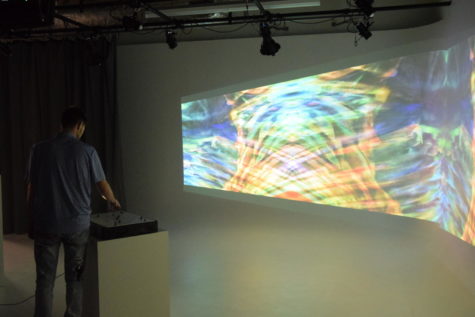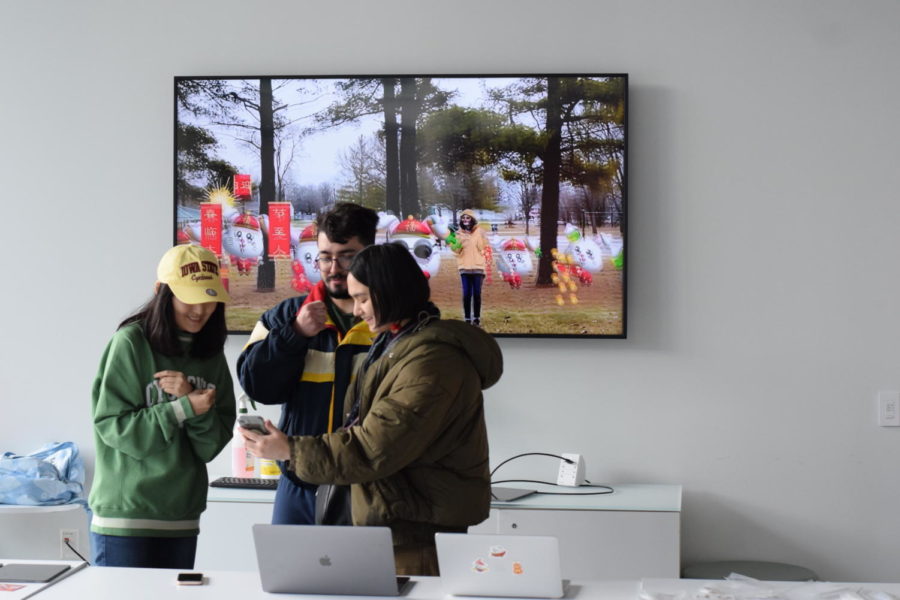Graphic design students share masters theses
Ge Qu (left) pictured sharing her digital stickers with two attendees of the show, Hiegata Goncalves and Maria (right) and Bruno Do Rosario Petrucci.
Graduating students from the College of Design’s master of fine arts graphic design and experiential graphic design programs shared their final thesis projects during the 2023 Graphic Design Show.
The show featured works from the program’s five graduating students as well as works of other students still enrolled in the program. The show took place from 5:30-7:30 p.m. Friday throughout the Student Innovation Center.
Alex Braidwood, associate professor of graphic design, said they had work from the whole graduate program on display. Besides the graduating students’ exhibits set up throughout the Student Innovation Center, the reception area included several TVs showing off work other students had submitted.
Braidwood said the show provides an opportunity for everybody to see each other’s work. He said oftentimes, students are so busy with their own projects that they do not always have a chance to see what’s going on with other students.
“The MFA [master of fine arts] is a three-year program, so you can very easily be in your first year and have no idea what the third years are doing,” Braidwood said. “So, by bringing it all into one space like this, we’re able to open that up not only to the public but also just even within our own cohort of students.”
Braidwood said seeing what other students are working on can be inspiring and help give students ideas of what they can or should be working on. He said getting out and seeing other students’ work broadens the scope of what people think the degree can be.
Students’ theses ranged from research on the elements of graphic design to interactive representations of emotional intelligence.
Stephanie Flattery, a graduate student in graphic design, had an exhibit showing off some 3D printed stim toys with some interactive augmented reality aspects.
Flattery said stimming, or repetitive self-stimulation, is a behavior often seen in people with forms of neurodivergence. She said people are often told to change their behavior even though it has no real negative effects.
“The thing is, stimming especially is something everyone does, but only autistic people are told not to do it,” Flattery said. “So, I wanted to find a way basically to show people that one, they stim, and two, what it does for them.”

Flattery said people better understand when stimming is when it is framed outside the ideas of normal behavior. She said clicking a pen, for example, is a common way many people stim, though people perceive it differently than other means of stimming.
“A lot of the misinformation out there is aimed at the adults that are in charge of getting treatment for their children and the next generation,” Flattery said, “so I think the best way to do that is target the non-autistic adults that get all this misinformation and harmful messaging around autism.”
Ge Qu, a graduate student in graphic design, created three sticker collections for different festivals. Not only did Qu create the traditional stickers but also transferred them into a digital format with augmented reality.
Qu said she plans to release the stickers on social media and for other public use. She also said she plans to continue exploring using them through augmented reality.
Marwa Elkashif, a graduate student in graphic design, presented her research on the ways new technologies are affecting the graphic design industry. She said with the increasing use of things like augmented and virtual reality, graphic designers are needing to work more with dimensions and space.
“So the main idea was okay if you’re dealing with these elements and principles in graphic design, what are the principles and elements that a graphic designer needs in order to gain all the 3D skills that they need to gain or to move on?” Elkashif said.
Elkashif said many books on graphic design use terms related to form and shape interchangeably, which can lead to confusion when teaching students.
“People say sometimes they don’t care about elements and principles, but it is the fundamental language or it’s a visual language; we actually use it,” Elkashif said.
Nishil Patel, a graduate student in graphic design, created a concept for an augmented-reality game incorporating designs and games into running. Patel’s concept included a set of augmented reality glasses that a user can wear while running.
Patel said his creative exploration for his thesis addressed the questions of what the challenges of an outdoor gaming experience are, what elements of gamification help integrate intrinsic motivation and how wearable technology can help people form new habits.
Logan Fredell, a graduate student in graphic design, created a program that takes inputs related to emotional stimuli and generates visual representations for the user’s emotional intelligence. The user interacts with the program through a console with a number of dials or sliders labeled with emotions or aspects of emotion.
Fredell said he wanted to use his thesis to touch on the concept of emotional intelligence in an interactive way.
“No matter what we can’t avoid emotion. It’s going on internally, whether we want to acknowledge it or not,” Fredell said, “so why don’t we take a look and make a visual representation of what’s going on internally.”
Your donation will support the student journalists of the Iowa State Daily. Your contribution will allow us to purchase equipment, send our student journalists to conferences and off-set their cost of living so they can continue to do best-in-the-nation work at the Iowa State Daily.














